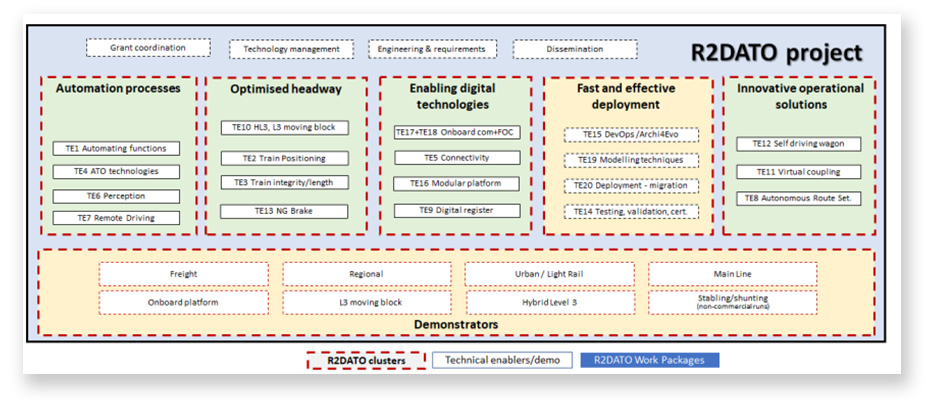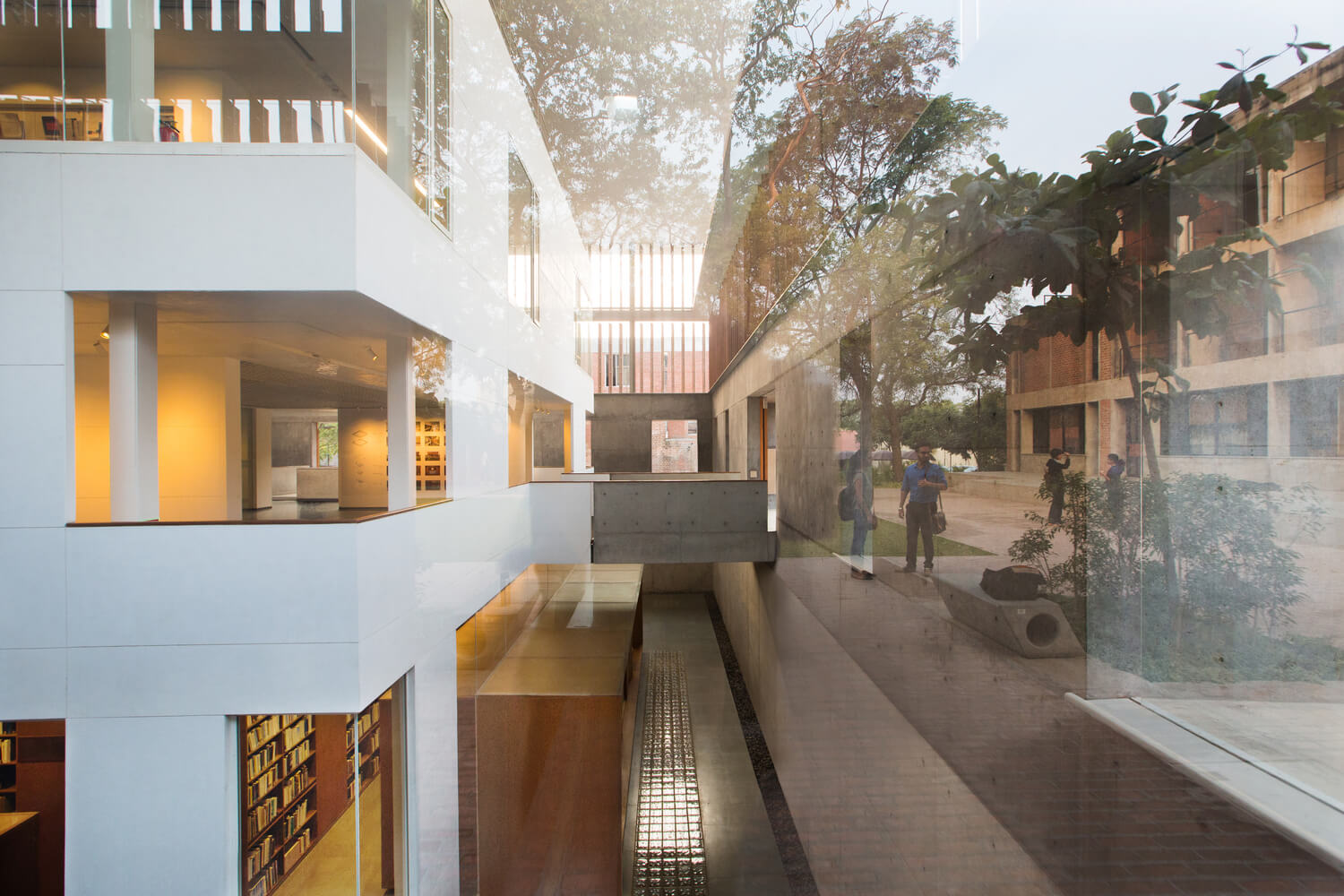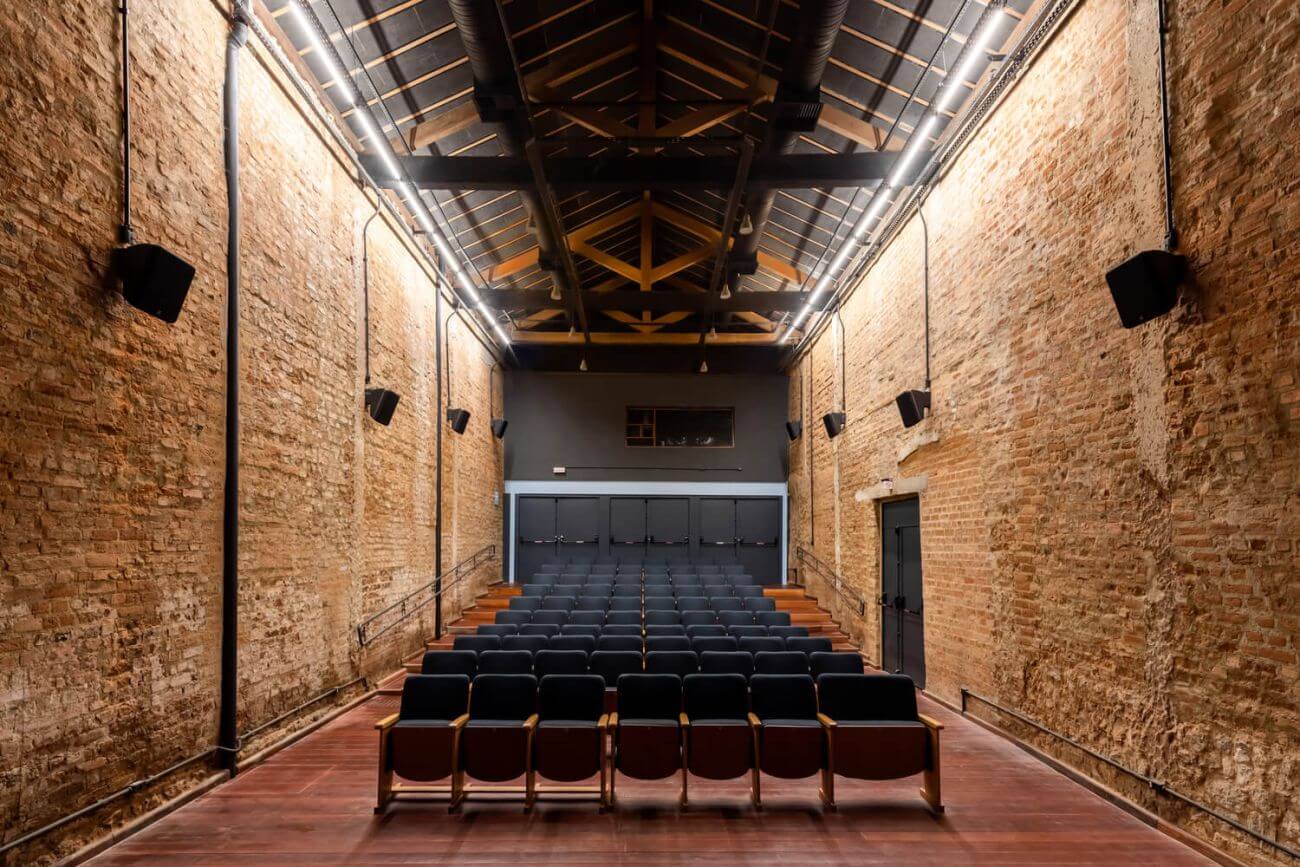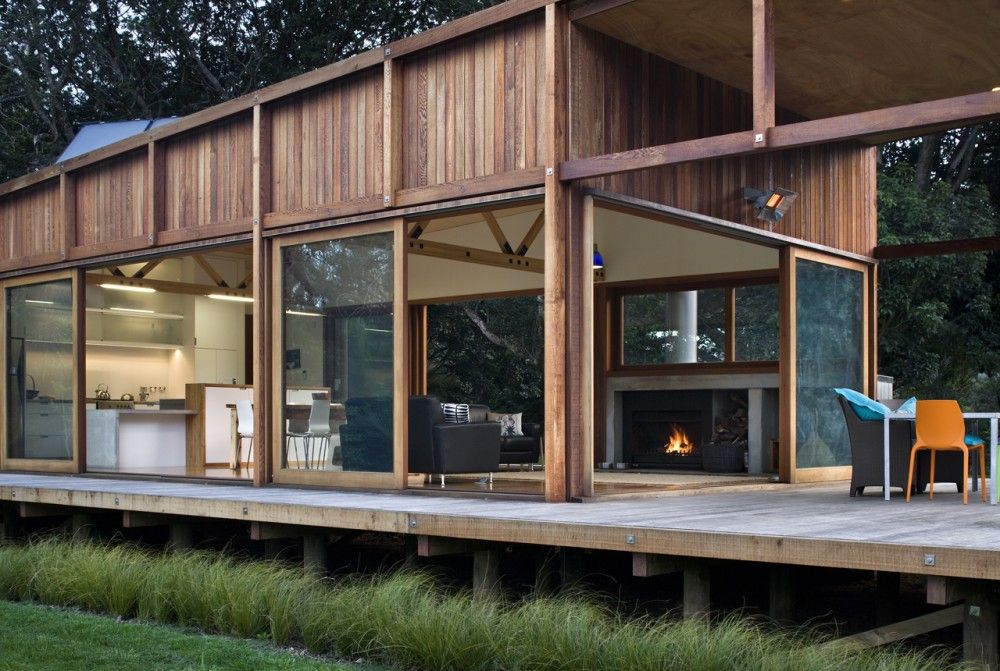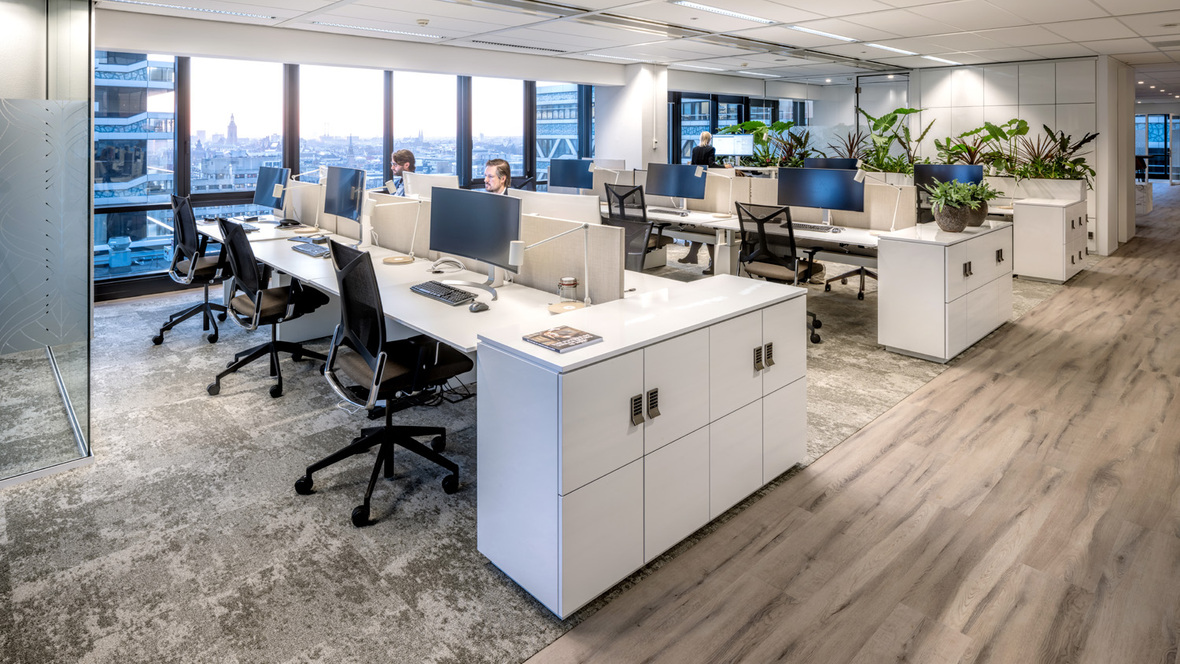CL2GEN Cluster 2 - General Meetings and Documents
PP folder for previous projects knowledges
WP00 Cluster leader Project manager and COordinator place
WP02 Technical Management and Coherence
The main objective of WP2 is to enable seamless and effective technical coordination and system integration within the FP2-R2DATO, by providing the leaders of all work packages with a platform for coherence checks and interface management. As a main objective of the EU-RAIL is to generate overall sector coherence, this WP will put an emphasis on interaction with the System Pillar (SP) and the other Flagship Projects (FP’s), primarily with FP1, FP5 and FP6, where strong interaction is to be expected during the implementation phase of this project.
WP03 Technical Engineering and Requirements Consistency
The objective of this WP is to coordinate the technical activities within the Flagship Area 2 as well as with the projects interacting with FP2-R2DATO to achieve the technical coherence of the Enabling technologies and the Demonstrators.
WP04 Automation Processes System View
This overarching WP coordinates activities within the cluster “Automation Processes” ensuring coherence within the subproject. The Technical Enablers (TE) of this cluster (TE-01: Automating Functions, TE-04: ATO Technology, TE-06: Perception, TE-07: Remote Driving, TE06.1: Data Factory) have strong links with other external Technical Enablers of this project, demonstrators and with other projects. Thus, another objective of this WP is to ensure seamless collaboration with them.
WP05 Automation Processes Use Cases and User Requirements
The goal of this work package is to identify already specified functions, use cases, user requirements or operational scenarios that must be considered in the rail automation processes (e.g., from S2R). Especially, items should be linked with components (e.g., ATO, ATP, TCMS, APM) and operational scenarios (e.g., Urban, Passenger, Freight). Based on input from the System Pillar, the definition of use cases, user requirements and operational parameters and scenarios must be consolidated, analysed, and extended. The purpose of the WP is to capture the current rail operator behaviour, high level user requirements and use those to design the automation system.
WP06 Automation Processes Specifications
WP6 will focus on the specification generation for the four technical enablers involved in Automation Processes. It involves taking the deliverables of the WP5 and performing a thorough Safety & Hazard Analysis to ensure all considerations are made in WP7 for a safe operation in ATO mode. Based on the analysis, this WP will define and develop an architecture and a system specification for the technical enablers. This work package addresses the evolution of DATO in railway and tramway sectors from a rolling stock perspective; by using outcomes from WP5 ensuring the harmonisation with other FP(s) and System Pillar.
WP07 GoA3/4 Data Factory specifications and Implementation
The development of highly automated rail operation up to GoA4 including automated perception and incidence management requires the acquisition, storage, simulation, and processing of a large amount of sensor data for AI training and validation purposes. The goal of this WP is setting the framework for a collaborative solution in the rail sector, the “Data Factory”, to jointly collect, store and annotate sensor data and build up all required infrastructure for processing the data as a prototype. This framework will leverage the outcome of Shift2Rail TAURO project, where a first version of it, including a PoC, is being developed. The common understanding is, that participants will share the perception- and localisation-sensor data recorded in WP11 during the FP2-R2DATO project among the work package participants for producing the Open-Data-Set.
WP08 Safety Analysis & Risk Assessment
The objective of WP8 is to centrally cover aspects of safety in the Automation Processes subproject. This activity requires close cooperation with System Pillar and the System Coherence (WP3). It covers the five Technical Enablers (Automating functions, ATO technologies, Perception & Data Factory and Remote Driving, and the activities carried out in previous Shift2Rail projects, such as X2Rail series of projects and TAURO will be considered as a relevant baseline.
WP09 Prototype development of automating functions
In this WP, functional prototypes for automating functions (TE 1) will be developed, tested, and validated against the defined system architecture specification (up to TRL4/5). There will be at least one prototype in cooperation with other FPs (e.g., FP5 for Freight and Depot/Yard, FP6 Regional lines) related to the proposed demonstrators and the relevant scopes. During the development of the prototypes the future migration from the state of the art to next generation DATO will be considered in cooperation with TE20“Migration and Deployment”.
WP10 Prototype development of Automated Driving (ATO Technologies)
The overall objective is to create a technical enabler suitable to demonstrators, considering the testing from S2R (e.g., pilot line and laboratory tests from the X2R1/5). The developed prototypes will be tested and validated against the defined system architecture specification.
WP11 Prototype development of perception system
This Work Package will focus on the detailed design, development, and validation of the Perception system (TE-06) defined in the Perception Architecture and System Specification up to TRL4/5. The scope shall also include the interfaces between the Perception System and its dependent technical enablers. At the validation side of the V-model, the interface testing will require coordination with the various technical enablers.
WP12 Prototype development of remote control
In this task, functional prototypes for remote control will be developed, tested, and validated against the defined system architecture specification. There should be at least one prototype in relation to the proposed demonstrators and the relevant scopes and in cooperation with other FAs (e.g., FA5 for Freight and Depot/Yard, FA6 Regional lines), to have an interim step towards demonstration of the technology.
WP13 Moving Block ETCS Level 3 – Specification
The overall objective is to define a high capacity, low cost, high reliability signalling system, based on a train-centric approach using Full Moving block principles. This Work Package builds on the future Functional Railway System Architecture defined by the System Pillar and the moving block specification defined in Shift2Rail (X2RAIL-1/3/5). The new signalling system shall dissolve the conventional separation of RBC and interlocking functionality and use a more generic and simplified safety logic by abandoning the long-established route concept and the accompanying static engineering processes. This Work Package will focus on System type Full Moving Block with Trackside Train Detection (TTD) as defined in S2R. Overall, this Work Package will align with the work to be done by the System Pillar.
WP14 Moving Block ETCS Level 3 – Prototype development & Analysis
The overall objective of this Work package is the development and test of Moving Block prototypes of up to TRL 6 based on the specification of the Moving block Specification Work Package. To facilitate the interoperability of new interface specifications, the prototypes will be developed independently
WP15 Hybrid Level 3 Specification
The overall objective of the HL3 Work Package is to align and integrate the Hybrid ERTMS/ETCS Level 3 (HL3) approach into the future Functional Railway System Architecture defined by the System Pillar and to apply the defined principles to different kinds of railways (e.g., high density lines have different needs in comparison to regional low traffic lines). For several Infrastructure Managers, HL3 is perceived as a faster and simpler way to increase capacity at a lower cost, maintaining a highly reliable signalling system, without the complexity of a Full Moving Block architecture.
WP16 Hybrid Level 3 – Prototype development & Analysis
The overall objective of this Work Package is the development and test of Hybrid Level 3 prototypes of up to TRL 6 based on the specification of the Hybrid Level 3 Specification Work Package. To ensure the interoperability of new interface specifications, the prototypes will be developed independently.
WP17 Next Generation Brake Systems with adhesion management functions – Phase 1: Demonstrator preparation and pre-validation
WP17 deals with brake and wheel/rail adhesion related solutions to be considered within ATO systems. In the work package, the impact and interrelation between brake/adhesion management systems (BAMS) to support future rail traffic and ATO systems are determined. New adhesion determination systems (ADS) and BAMS functions will be delivered and pre-validated (test rigs, research trains, demonstrator). Beyond, work on standards/regulations will be performed with ATO/ETC experts to facilitate the application of the new solutions and to be able to influence the trains’ braking curves.
WP18 Next Generation Brake Systems with adhesion management functions – Phase 2: Operational validation/demonstration
This work package will mainly deal with BAMS to be considered within ATO systems as well as safety related ATP systems (ETCS). As continuation of WP17 complementary objectives will be followed, as an impact and interrelation analysis between BAMS and ATP systems. The work on certification and adhesion determination methods started in WP17 will be continued. As an expansion, the possibilities of future dynamic braking curve adaptation (effect, benefits, technical implication) will be examined.
WP19 Consolidation of Train Integrity & Trail Length Determination Specification
In the ETCS Level3, where trackside train detection systems are not mandatory, it is necessary to check the integrity of the train using an on-board system. Moreover, for simplification of the driver activities at the start of mission, it is important to adopt an independent system able to calculate the length of the train. In order to realise this, the Train Integrity and Train Length Determination work package uses the results obtained in the previous X2Rail-2 and X2Rail-4 projects in addition to those of the future DAC (FA5) project. In particular, the collaboration with the DAC project will serve to consolidate a solution that can be used in any operational context, taking into account the input coming from the System Pillar. The expected goal of this work package is the consolidation of requirements for the Train Integrity and Train Length Determination solutions and their insertion into the on-board architecture.
WP20 Development of Train Integrity & Train Length Determination Demonstrators
Starting from the activities performed in WP19, this WP focuses on the development of suitable solutions and on the consolidation of the specification with feedback coming from test activities. The architectural solution will be established in conformance to the inputs from the System Pillar. The expected goals within these tasks are a further consolidation of the specifications, the performance of a safety analysis and the realisation of demonstrators for the Train Integrity and/or Train Length Determination function.
WP21 Absolute Safe Train Positioning (ASTP) - operational needs
The challenge of this activity is to provide Absolute Safe Train Positioning solutions with more accurate position and speed, which will provide possibilities of optimising headway as well as energy train control assistance (ATO), allowing energy saving and densification of trains (+30%) with less trackside equipment. ASTP will reduce maintenance costs and improve availability within equivalent safety considerations. ASTP focuses on the development of modular and scalable absolute safe train positioning system. It serves all CCS (and non-CCS) functions such as ATP, ATO, ATS/TMS, TCMS, applications of RU in train (e.g., DAS or travel-information) or on trackside. Then ASTP system should be scalable for different Safety Integrity Levels to cover the wide range of applications from low cost to high end resolution applications. Addressing the targets above, this work package deals with following objectives:
- Identify common high-level user needs and system capabilities of ASTP.
- Analysis of required system performance for the ASTP system.
- The TRL level associated to the documents produced in this WP is 6. When available, public results from other European initiatives like CLUG/CLUG2 will be considered in the frame of FP2-R2DATO for the Absolute Safe Train Positioning activities: those inputs will be evaluated and integrated when commonly agreed by this WP.
WP22 Absolute Safe Train Positioning - System Architecture, Design & RAMS
Absolute Safe Train Positioning systems designed in this framework shall provide train location and kinematic data (speed, acceleration) to address each and/or all the use cases from operational context listed in WP21. First steps in mastering safety of the solutions shall also be addressed. This work package complements the goals of WP21 and delivers following added value:
- Definition of a ASTP system architecture and its design in order to reach TRL 6-7, also covering external interfaces, testing, and validations procedures. The work shall also cover safety evidence, including the interaction with the digital map server (e.g., transmission through FRMCS to the Onboard incl. version check).
- The testing of the developed ASTP solutions.
- General assessment and evaluation of ASTP solutions, as well as the impact analysis of ASTP with regard to TSI gaps, need for TSI CSS modifications.
WP23 Onboard Communications – Communication foundations and basic functionality
A modular and upgradeable next-generation ATC asks for a seamless communication among on-train domains. The new Onboard Communication Network (aka One Common Bus), as started in the ERA TWG Train Architecture, will be a big step forward in that direction. Starting from the CCS and FRMCS systems, it will offer further separated logical domains of TCMS, Operator Oriented Services (OOS) and Customer Oriented Services (COS) to use the same (physical) network. The Onboard Communication Network shall be cost-efficient (from LCC and TCO point of view). This enabler will also address migration questions from existing technologies in scope of the onboard networks as well as the interoperability and integration for train backbone networks. In the first phase of EU-RAIL, the enabler focusses on foundations for the onboard communication network - building upon and substantially extending the prior work from CONNECTA and OCORA beyond TCMS and CCS and also toward higher protocol layers -and overall strives for a TRL of 4/5 (technology validated in a lab setup that represents practical train deployments). For higher level TRLs the later phases of the projects will be used. This WP focusses on the communication functionality plus building up a lab environment for PoCs.
WP24 Onboard Communications – Network management functionality, processes and overall integration
While the former WP focusses on the communication functionality, this WP focusses mainly on the network management functionality and the CCS/TCMS interoperability. For the overall intention see WP23. Due to the complete novelty of this work, the aim in this WP is a TRL of 4.
WP25 Connectivity Development – FRMCS
Connectivity between train and trackside is obviously key for automated rail operations. Many European railways have already launched the preparation of the 5G-based Future Railway Mobile Communications System (FRMCS) successor of the GSM-R/GPRS installation used today in rail operations, since the future operational connectivity requirements are exceeding by far the capabilities of the current GSM-R/GPRS.
WP26 Modular Platforms Specification
This work package focuses on developing the architecture and specifications for the development, testing, and certification of modular and safe computing platforms for onboard and trackside systems which host safety-related and non-safety related functions, incl. standardized approaches for monitoring, diagnostics, and configuration management. As depicted in the System Pillar Report, the envisioned computing platforms shall separate SW from HW to resolve several issues with obsolescence, upgradeability as well as underlying services for communication, remote maintenance, and security.
WP27 Digital Register Specification, Development and Implementation
This activity focuses on the specification, development, and implementation of the Digital Register in the sense of a database supporting assisted and automated train operations (including, e.g., traffic management systems) and optionally safe train positioning. The Digital Register will be based on prior work in Shift2Rail (TAURO) and RCA. The Digital Register shall provide reliable, interoperable and accessible infrastructure information as critical enabler for safety-related and non-safety-related functions. Among information provision needs, a key priority will be the development of a reliable Digital Map supporting assisted and automated train operation. The focus of the WP will specifically be on: · The development and implementation of the Digital Register itself.
WP28 Connectivity Development – ACS/Gigabit Train
This work package will investigate how multiple radio bearers can be used concurrently to serve the needs of both the Gigabit train and future rail operations, and how the FRMCS architecture and specifications can potentially be expanded in this direction.
WP29 Rail industrial DevOps and Architecting4evolution
Rail industry and rail operators face significant challenges that result in conflicting time scales for operations (long, with the need for adaptions and changes over decades) on the one hand, and realisation of new features and fixes (short, shall be brought into the field much faster than today) on the other hand. For the long timescale we propose to explore ways to improve the evolvability of architectures and for the quick realisation we propose to focus on ideas from the DevOps approach. Both must be done consistently with requirements from standards and regulations, harsh environment, safety-criticality, and long lifetime. To determine the right granularity of being technology-independent while preserving applicability in practice will be the key question.
WP30 Automated authorisation by modelling techniques
Authorisation of products and of modifications of railway assets is still widely based on human judgement. It is a big risk and therefore a major cost driver in commercial projects. Modelling techniques and their continuous evolution have the potential to enable a rigid and robust verification of a product or asset against predefined functional requirements. Building upon 5 years of research and development in semiformal and Formal Methods in Shift2Rail, this work package will allow the use of modelling techniques incorporating formal methods to address the basic needs of rail stakeholders This work package is focused on modelling techniques for automated formalisation thus enabling also automated authorisation.
WP31 Automated Train Supervision and Control
This WP builds upon the objectives and principles of WP 30 and extends it further. This work package is focused on delivering and developing (a) a functional correct model for ATO Onboard and Remote Supervision & Control, and (b) formal modelling and specification of TCMS Data Service.
WP32 DATO Assessment and Potential identification
This WP intends to provide information and fundamental guidelines for defining the potential benefits of future ATO operations and preparation guidelines/requirements for future ATO demonstration and operations. The main objective is to illustrate the attractiveness of DATO and to smoothen and accelerate the deployment of DATO technology in European networks.
WP33 Migration and Deployment guidelines
This WP intends to provide information for migration & deployment strategies. The main objective is to illustrate the potential to deploy DATO technology in European networks, both from a technical and a people-oriented perspective. This will be based on the inventory of optimal migration strategies toward applying DATO technology, partly based on lessons learned from field demonstrators. Integration and alignment of best practice and lessons learned from practical field tests and result coming from other demonstrators in FP2-R2DATO.
WP34 Testing, Validation and Certification - Test Specification and architecture
Cost efficient deployment is one of the main drivers of operational excellence and competitiveness in nowadays railway environment. The approval and the testing of complex systems including their continuous update and upgrade are one of the influencing factors of the cost-efficient deployment. Furthermore safety, cybersecurity, interoperability, and interchangeability are key attributes to be supported. To achieve these goals, the testing, validation, and certification is focusing on continuous improvement of the testing process strongly influenced by specific deployments and tailoring of the safety procedures defined within the CENELEC environment. In addition, the migration towards a single European railway architecture defined for the CCS+ opens the opportunity to also streamline approval processes.
WP35 Testing, Validation and Certification - Implementation and Certification
This WP35 will be a continuation of the activity started on the WP34, considering their results and outcomes as input for the implementation of the new activities.
WP36 Onboard Platform Demonstrator
The aim of this demonstrator is to implement and validate a prototype and blueprint of the future-proof onboard connectivity and IT platforms that are required in a highly automated rail system, with the expectation that latest from EU-RAIL phase 2 on all larger-scale demonstrators would utilize these platforms. The aim of this demonstrator is to implement and validate in a lab environment (up to TRL 5/6) how railway application(s) can be hosted on a modular computing platform, making use of a safe Runtime Environment (RTE), standardized Platform Independent (PI) API, onboard FRMCS functions and a unified diagnostics service API. As a key outcome, the demonstrator will help to determine an appropriate level of onboard platform modularity and aggregation (e.g., by utilising a common hardware pool, most likely through the usage of virtualisation or hypervisor technology), and to prove the feasibility of hardware independent integrability and potential certifiability as a blueprint for EU-RAIL phase 2 and future larger-scale demonstrators.
WP37 ETCS HL3 Deployment Strategies
Given the readiness for deployment of ETCS Hybrid Level 3 methods to reduce lead-time to implementation and smart line-design methodologies will be developed.
WP38 Automatic Stabling, Shunting, and Non-commercial runs Demonstrator
The objectives of the demonstrator are testing the performance of the technical enabler(s) incorporated in the demonstrator, providing feedback to the TE-developer, in order to improve the functioning of the TE, or to enhance/improve/modify the specifications and performing measurements to show the improvement of the new (sub)system over the existing system, to contribute to the realisation of the KPIs defined in the call.
WP39 ATO over ERTMS demonstration on mainline
Mainline, is here defined as the most complex kind of operations in a network, mostly around large nodes that can't be demonstrated in full service by 2026. Therefore, modelling ATO and its operational concept as well the linkage of TMS to ATO dynamically anticipating in these complex nodes will be developed, tested and designed. Furthermore, showing the relevant advantages deriving from the synergy between the digital automatic train operation up to GoA 4 and the CCS evolution, increasing the capacity and punctuality of railway lines, by enabling ETCS L3 moving block with minimum infrastructure elements.
WP40 Autonomous Tram Demonstrator
The main objective of this WP is to make two trams ready for demonstration of different use cases and technologies along the project lifetime, which means to design, modify, and integrate appropriated systems which allows development of autonomous driving functions.
WP41 Remote Driving and Telecommand Demonstrator
Identification of use cases for the first demonstrator, development, implementation, and validation through a specific demonstrator in Oslo. The objective of this second work package is to implement a REMOTE DRIVING AND TELECOMMAND demonstrator up to TRL7.
WP42 Tramway autonomous movements in depot demonstrator
Identify use cases to be implemented in the second demonstrator, development, implementation, and validation through a specific demonstrator in Oslo. The objective of this third work package is to implement an AUTONOMOUS MOVEMENTS demonstrator up to TRL6.
WP43 Freight Demonstrator
To allow a smooth deployment of GoA 4 technology with different possible technological solutions, the systems need to be tested in real conditions in a demonstrator. The freight demonstrator will be equipped with sub-systems studied in the Technical Enablers. Tests will be performed, enhancing autonomous freight train operations.
WP44 Moving Block ETCS L3 Demonstrator – Specification
The main objectives of this work package are to prepare the ground for a successful demonstrator. To achieve this the following tasks, need to be worked on identifying relevant use cases/test cases to demonstrate and providing a demonstrator specific specification (architecture, functional requirements, interfaces) Major input are the results provided by System Pillar and the relevant Technical Enablers.
WP45 Moving Block ETCS L3 Demonstrator – Realisation
The main objective is to demonstrate a modular train-centric trackside protection system enabling moving block operations with generic safety core up to TRL6 in FP2-R2DATO. By doing that we want to prove that; the architecture (incl. standardised interfaces) based on System Pillar results is feasible, the train-centric ccs logic has additional benefits compared to a block-centric operation, the generic safety logic is a valid concept, the system can operate with any train equipped with radio based ETCS (Level 2/3/R) the system can use any combination of trackside localisation (e.g., axle counter) and on-board localisation (e.g., train integrity) to determine the safe trackside view of track occupancy (hybrid sensor configurations, without “thinking” in blocks).
WP46 Regional line demonstrations
The main objective of this WP is to provide the bridge between FP2-R2DATO and FA6 demonstrations by supporting validation and testing of technical enablers in regional line environment before they are handed over to FA6 for further adaptation and integration. The improved CCS and automation functions will be the main technologies tested and validated, building on the activities already performed in the scope of Shift2Rail ATO (up to GoA4) tests (the very same line and vehicle). Further, the line will be used to support development process of technical enablers, even on lower TRL levels, due to simplified operational environment and flexible demonstrations planning (no regular commercial service, the line fully dedicated to tests) and approval process. Minimal set of technical enablers needed:
- Automating functions
- ATO
- Perception systems
- Digital register
- Absolute safe-train positioning
WP47 Dissemination, communication and exploitation of results
The main objective of this work package is to ensure that the project results & outputs are disseminated widely as well as effectively exploited by their target group across Europe’s Rail JU, rail sector, and beyond. To ensure efficient communication and dissemination activities a multi-level approach will be followed. Dedicated exploitation activities will enable the project results to be fully implemented and widely used afterwards, thus ensuring a sustainable impact of the project in the long run.
WP48 Innovative Operational Solutions
This work package aims for specific innovative use cases targeting for solutions with even higher grades of automation closer to autonomy. It is one approach to operate trains, consists or even individual vehicles as e.g., freight wagons individually and to enable the infrastructure to react on the requests set by those vehicles. Consequently, this WP shall focus on three innovative operational solutions, which are core to enable this approach, namely, Autonomous Route Setting (AnRS), Virtually Coupled Train Sets (VCTS) and Self-Driving Freight Wagons (SDFW). These operational solutions rely on two core technology elements related to communication and localisation: short-range communication (SRC) and relative localisation (RL). Both technologies are required in addition to normal train-to ground communication (e.g., by FRMCS) and absolute localisation (e.g., by GNSS), which are subject of other WPs in the project. Hence, this WP will focus on the further development based on the state of the art.
